How to Purge Your Stuff Ruthlessly & Declutter Guilt-Free
This post may contain affiliate links, which means I may receive compensation if you make a purchase using one of these links.
Our homes are filled with clutter, accumulated over time because we think it serves us in some way. The reality, however, is that most of our stuff doesn’t serve a purpose, or even get used at all. Gathering up all the things you don’t like or want is the surface level start to decluttering. After that, things get a little harder as you dig deeper. Here’s how to purge your stuff ruthlessly and declutter guilt-free.
When it comes to letting go of items you may actually like, it’s time to dig into the heart work and ask some serious questions.
- How does this item make me feel (positive or negative)?
- Where did this item come from?
- Is it serving me and meeting a purpose?
- Can I live without this item, or do I need and use it on a regular basis?
Don’t let items that bring up negative emotions stay in your home. Don’t keep items just because someone gave it to you. Don’t keep items that don’t serve you. Don’t keep items you don’t need.
When you let go of things, you’re creating breathing room and more space for the things that actually serve you well. Let’s look at some common areas that trip us up when decluttering and how to breakthrough and ruthlessly purge your stuff.
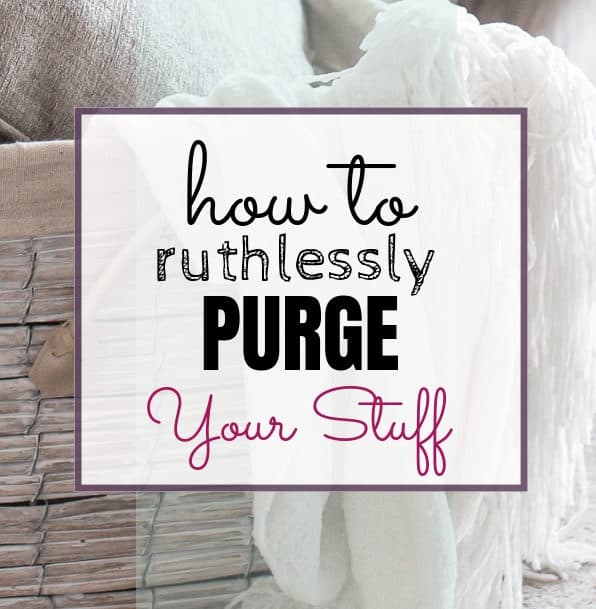
That Item That Reminds You of Failure
Years ago I wanted to start meal planning. So I hopped on Pinterest for inspiration and found this super adorable menu board someone had made to display their weekly meal choices. Of course, I needed to make my own. It was very cute and I loved the way it looked, but I used it about three times and then never again. Ever.
For over three years, an item I never used was on the wall in my home, reminding me that I was failing in meal planning and as a housewife. It did serve the purpose of wall decor, and it was cute, but ultimately, it left me with negative feelings about what I wasn’t doing right and just added to the clutter.
- Do you love it, but it doesn’t serve you anymore? Declutter.
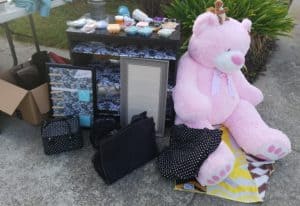
In similar fashion, I’ve had many magnetic dry erase “organization” boards on the fridge over the years, and while weekly plans and lists can be incredibly helpful, I never found myself consistently using these boards, and instead they were adding to the clutter on the fridge.
- Is there something else that can serve you better and reduce the clutter? Declutter.
Feeling guilty about decluttering stuff? Dig into overcoming buyer’s remorse here.
The Bookcase Packed With Books
Books are among the most common home (and work) collections and are easy to become attached to. Most of us are under the impression that having a family library is a normal and expected part of the home, especially if you have children. Don’t they need their own extensive library?
I’d like to challenge that.
Books are fantastic and children should own books! Parents too. However, owning shelves of books you do not read is unnecessary clutter, especially if you have access to a local public library or bookstore.
Go through your bookshelves with grace and ruthless abandon. It may take you several purges to really get your collection where you want it. The most loved and read books.
If you have already read the book, ask yourself:
- Do I love this book? Will I ever read it again? (If you will, consider keeping it)
- Is it applicable to my current stage of life? (If not, consider donating it)
- Is it a book I need to reference often? (Consider keeping)
- Instead of keeping the physical book, can I find the information at the library, on Google, from a friend or bookstore? (Consider donating)
If you have not read the book yet, ask yourself:
- Why haven’t I read this book yet?
- Am I still interested in the topic?
- Is it applicable to my current stage of life? (Consider donating)
- Instead of keeping the physical book, can I find the information at the library, on Google, from a friend or bookstore? (Consider donating)
If you haven’t read it yet, but you’re still interested in the topic and have just been procrastinating reading it, choose to make it a priority. Set it on your desk or nightstand and begin reading it today!
Consider cultivating a curated bookshelf with just the books that you love, read, refer to and inspire you.
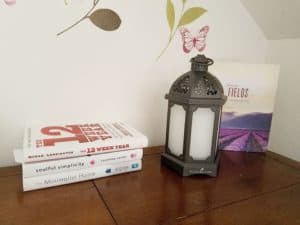
Regarding Children’s Books
For children’s books, if your child is over the age of three, include them in the decluttering process. Younger than that, you may take the lead.
- Keep: Beloved favorites read over and over
- Keep: Books in their current reading stage (for example, board books (newborn-3 years old), picture books (2-6), beginning readers (3-7), chapter books (6-10), tween (10-14), young adult (13-18), etc.)
- Donate: Books from previous (and perhaps very future) stages that are not being chosen to read regularly
- Recycle: Books in ragged condition
Consider boundaries with a children’s library. A basket, one shelf, or a box will keep the books neat and give a physical space the child recognizes as their very own book collection to care for.
Letting Go of the Past: Sentimental Items
There are layers to purging sentimental items, but when you’re first starting to declutter, keep these tips in mind:
Start off by creating a digital filing system on your Cloud storage (Google Drive, iCloud, Dropbox, Evernote, etc.). Make folders for things like childhood memories, projects, arts and crafts, and letters.
- Take a digital photo of items such as childhood crafts, toys, artwork, and memorabilia that you feel you can let go of and store them in folders on the Cloud, then get rid of the physical item
- Digitize excess photographs in a similar fashion on the Cloud and let go of extra physical prints
- Scan documents, letters and greeting cards that are sentimental and upload to the Cloud, parting with the physical copy
It will take time to go through sentimental items, but ask yourself to be honest:
- Where did this item come from?
- What does it mean to me?
- Can I put this physical item to use or display in our home for everyone’s enjoyment (instead of in storage)?
- Is the item in poor condition? Take a picture and discard the item properly.
You don’t need the physical item to maintain a memory, but taking a picture or putting the item to use can honor the very special people and in our lives. Be ruthless by picking out just a few items to keep that are your most favorite, and consider parting with the rest.
Give yourself grace as you go through sentimental items. You won’t be able to do it all at once, and it may take several sessions to decide which difficult items to keep or let go.

Let’s tackle the guilt
Clutter often sticks around because you feel guilty.
- I spent a lot of money on it
Acknowledge the money is gone, and it’s time to let go of the past and move forward with a commitment to be more intentional about your purchases. Don’t repeat the mistakes of the past!
- Someone gave it to me
Do not keep it just because someone gave it to you. Keep what you love that serves a purpose, and let go of the things that are just things.
- I thought I would use it, but I don’t
Buyer’s remorse is ugly and keeps us emotionally stuck. Dig deeper into how to let go of guilt-filled items here.
- This item is good stuff, I can’t get rid of it!
Sometimes you have to let go of the good things in life to make room for the great things. Homes are filled with clutter that is “good stuff”. If you aren’t using it–it’s not good for you.
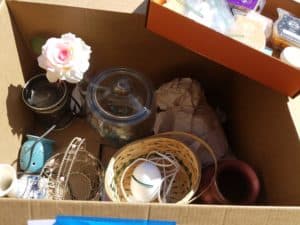
What Happens When You Ruthlessly Purge Your Stuff
Something magical happens when you let go of good stuff. First, it blesses other people who can actually use and benefit from the items. And secondly, it lifts the weight on your heart.
You might feel like you can breathe more easily in your home. You might be able to sit in your living room and feel peaceful for the first time ever. Your family might feel the life-changing effects of freedom.
Letting your stuff control your life by increasing your stress and household workload is damaging over the course of your life. You don’t have to live that way! It takes time to dig deep and go through the difficult, sentimental and even loved stuff in your home.
The more you let go of things that don’t serve you (as most of our stuff doesn’t), the more joy you’ll experience in your life and home. That’s worth the effort! Dig deep. Challenge yourself. You can do it!
Looking for More Decluttering Inspiration?
Clearing Clutter from Your Life Using the Quick Win Principle
Decluttering Quick Start Guide || 5 Areas in Your Home in 10 Minutes or Less
5 Simple Ways to Minimize Your Kitchen Today
WANT TO SAVE HOW TO RUTHLESSLY PURGE YOUR STUFF FOR LATER?PIN TO YOUR FAVORITE PINTEREST BOARD HERE:
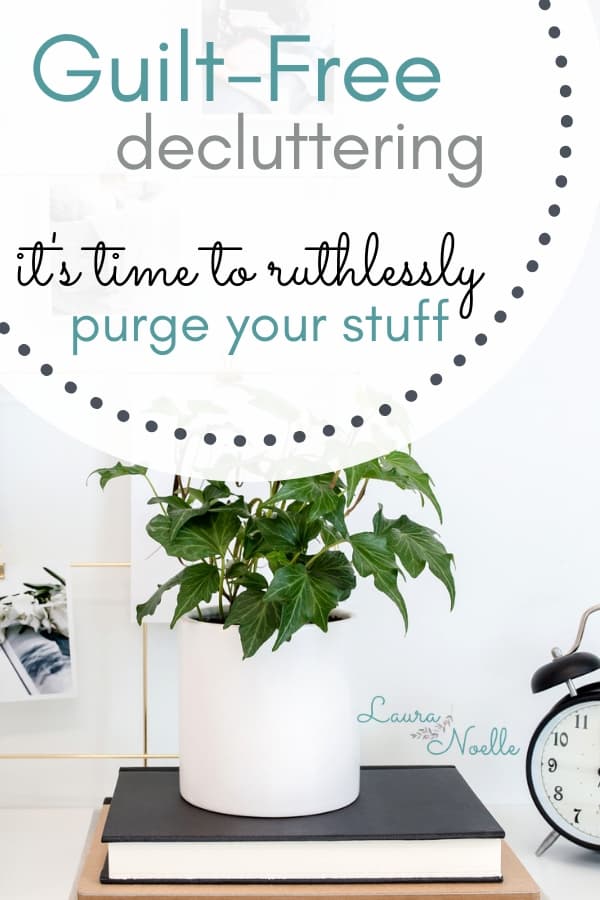

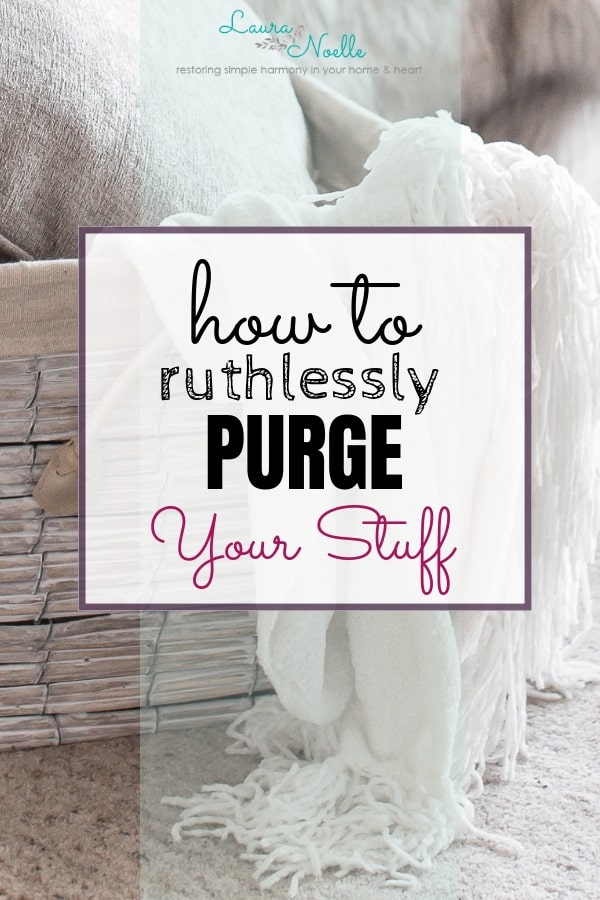
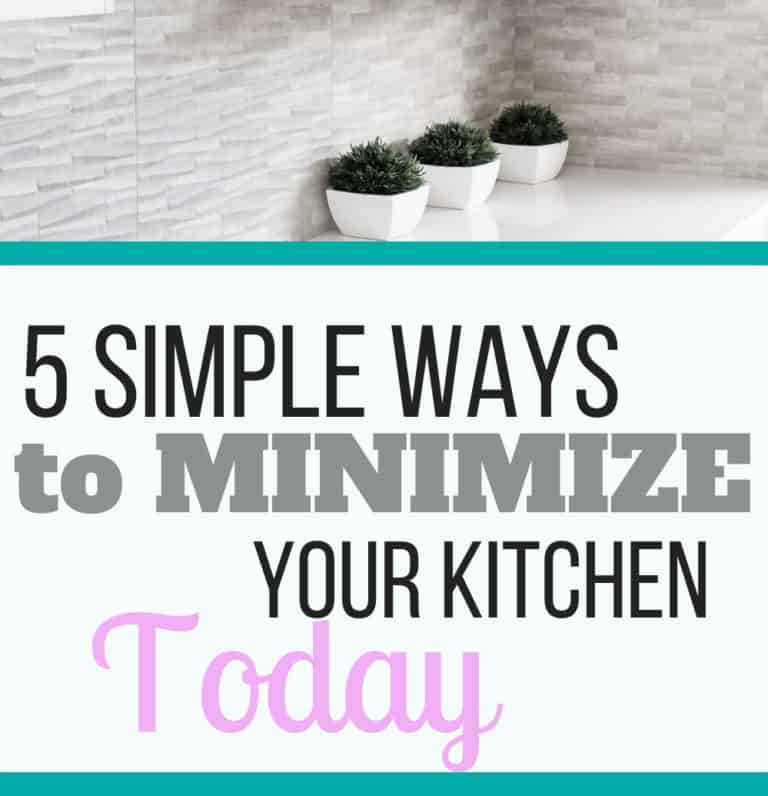

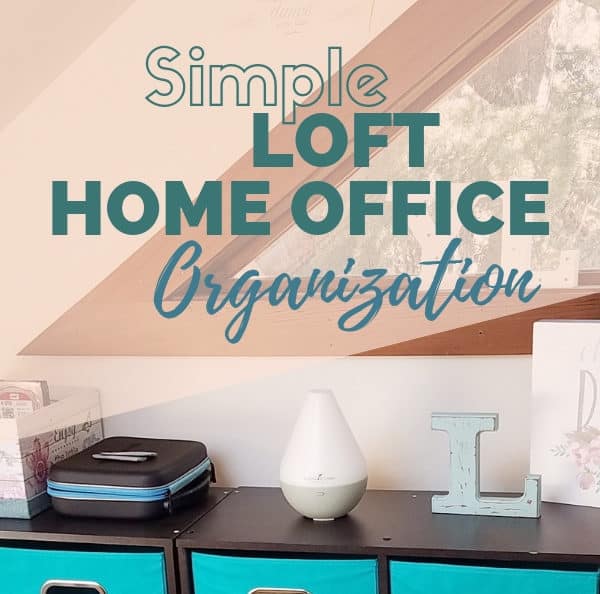
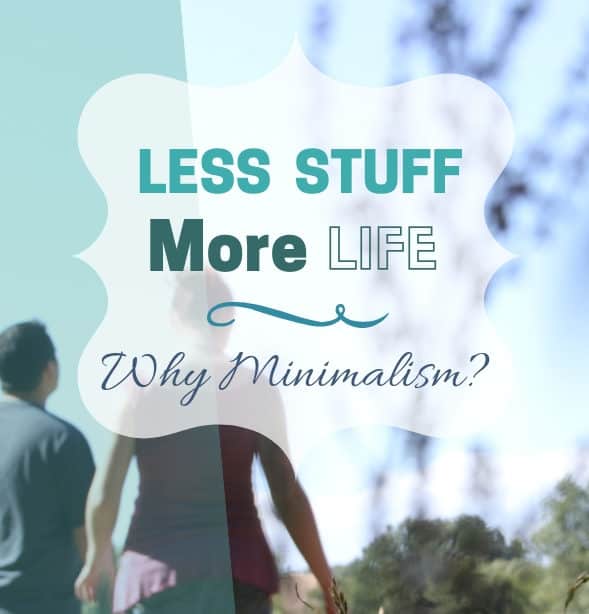
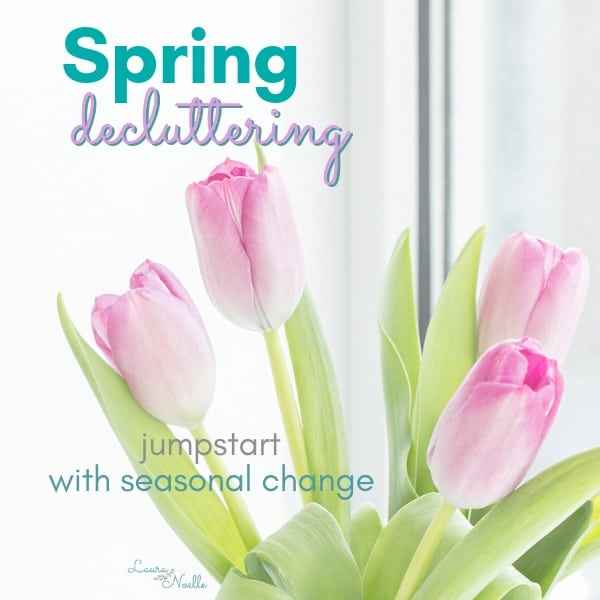
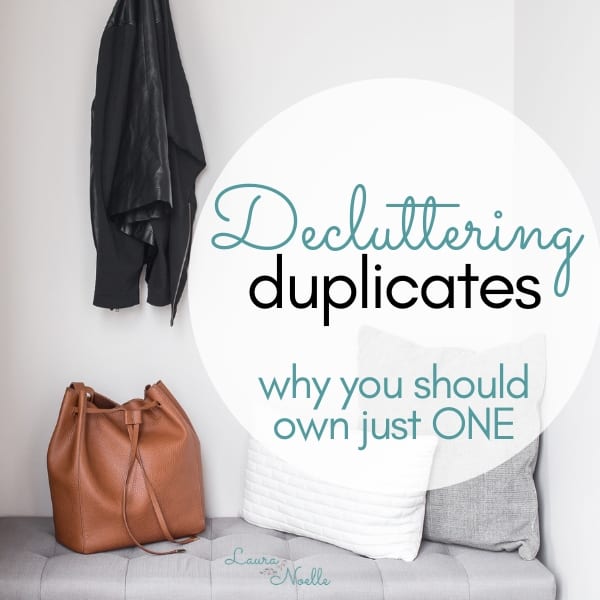
This is the wisdom I NEED to hear to push me to Declutter home/life! Thank You!
Aw thank you, Lil! I’m so glad it was helpful to you!! Happy decluttering!!
Love to read it .
It’s a great lessons indeed.
Learning to follow it religiously. Stuff free means Stress-free.
This article seemed really interesting, but there were so many ads that my laptop slowed down. I couldn’t even read it with the amount of pop ups. Too bad!
I’m of two minds on the book thing.
I still recall exactly how many books were in my mother’s house when I was growing up. 23.
My father’s house had too many to count.
They were both wrong. It is hard to let go of books, and it is hard to know what to keep. Basically, I keep books either that I still want to read (even if I never will), and books that I have read and annotated (those notes come in handy).
I could let go of more, but finding that balance is challenging. Must say, it gets easier as I get older, and can see I probably have at most 15 or 20 years left in my life. It’s easier to see that I won’t read all those books in that time.